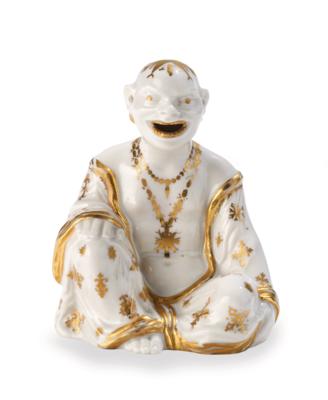A Böttger ‘Pagoda’, Meissen c. 1720
Böttger porcelain, glazed and partly gilt, hollowed figure of a bald-headed seated man with his left leg underneath, the right hand placed on the raised knee, the robe-like garment exposing the shoulders, chest and belly, the mouth wide open in a smile, pupils, teeth and tufts of hair behind the ears and two necklaces in partial gilding, garment hem, stylised leaf and star ornaments on the garment and crown of the head, height 9 cm, unmarked, gilding scuffed, (GO)
The first mould of this figure in Böttger stoneware is dated to late 1711, or shortly thereafter, and is attributed to either the sculptor and Permoser student Johann Joachim Kretschmar or the court sculptor Johann Benjamin Thomae. From 1713 onwards, they were executed in the white hard porcelain newly developed by Böttger. These small-size figures were very popular and after Böttger's death in 1719 there were still “40 small idols” in the warehouse of Albrechtsburg Castle. Also in 1719, a large number of other idols were marked in the warehouse for the Leipzig Fair, showing that there was also a demand on the bourgeois market. The success of this figure lasted for about two decades as can be seen from the total of over 1,600 manufactured idols mentioned in the work journals between 1722-1728.
The purpose of these figures is apparently quite mundane at first. They were used as incense burners and are clearly named in the inventory of the ‘Japanisches Palais’ as “Ten seated idols, to serve as incense burners”.
However, the shape design and utility are exemplary testimony to the influence of Chinese and Japanese imported porcelains in both use and style. Asian incense burners, also in the form of miniature architecture, such as the pagoda type of building, were known and used for this purpose in Europe. This explains the German terms ‘Pagode’ and ‘Räucherpagode’ for this type of figure.
Motifs of incense burning as a typical Asian ritual or for religious purification are also found in varied form in the paintings of the later Höroldt workshop.
These imaginary worlds of faraway Asia, which served as manifold inspirations for the early Meissen porcelains in form and decoration, were described in Europe in the visual arts and literature, as a paradisiacal place. Thus, the image of Asia develops as an exotic place in whose everyday life one was occupied mainly with the production and use of luxury products known by import, such as silk, tea, porcelain and other fine arts, like philosophy.
The caricaturised design of this porcelain figure, deliberately contradicting the European conventions of aesthetics, with bare chest, bald head, wide open mouth and its detailed teeth, generally leans on the model of a Chinese saint, such as the Bodhisattva Budai or the god of luck “Pu-tai-Ho-shang”.
Provenance:
Viennese Private Ownership
Lit.:
Santagelo, Maria (ed.): A Princley Pursuit: The Malcom Grutter Collection of Early Meissen Porcelain, San Francisco/ Munich 2018, pp. 62-67.
Exhibition catalogue: The Arnhold Collection of Meissen Porcelain 1710–50, London 2008, pp. 238–239.
Esperto: M.A. Georg Ottomeyer
 M.A. Georg Ottomeyer
M.A. Georg Ottomeyer
+43-1-515 60-538
georg.ottomeyer@dorotheum.at
25.04.2024 - 13:00
- Prezzo realizzato: **
-
EUR 10.400,-
- Stima:
-
EUR 8.000,- a EUR 12.000,-
A Böttger ‘Pagoda’, Meissen c. 1720
Böttger porcelain, glazed and partly gilt, hollowed figure of a bald-headed seated man with his left leg underneath, the right hand placed on the raised knee, the robe-like garment exposing the shoulders, chest and belly, the mouth wide open in a smile, pupils, teeth and tufts of hair behind the ears and two necklaces in partial gilding, garment hem, stylised leaf and star ornaments on the garment and crown of the head, height 9 cm, unmarked, gilding scuffed, (GO)
The first mould of this figure in Böttger stoneware is dated to late 1711, or shortly thereafter, and is attributed to either the sculptor and Permoser student Johann Joachim Kretschmar or the court sculptor Johann Benjamin Thomae. From 1713 onwards, they were executed in the white hard porcelain newly developed by Böttger. These small-size figures were very popular and after Böttger's death in 1719 there were still “40 small idols” in the warehouse of Albrechtsburg Castle. Also in 1719, a large number of other idols were marked in the warehouse for the Leipzig Fair, showing that there was also a demand on the bourgeois market. The success of this figure lasted for about two decades as can be seen from the total of over 1,600 manufactured idols mentioned in the work journals between 1722-1728.
The purpose of these figures is apparently quite mundane at first. They were used as incense burners and are clearly named in the inventory of the ‘Japanisches Palais’ as “Ten seated idols, to serve as incense burners”.
However, the shape design and utility are exemplary testimony to the influence of Chinese and Japanese imported porcelains in both use and style. Asian incense burners, also in the form of miniature architecture, such as the pagoda type of building, were known and used for this purpose in Europe. This explains the German terms ‘Pagode’ and ‘Räucherpagode’ for this type of figure.
Motifs of incense burning as a typical Asian ritual or for religious purification are also found in varied form in the paintings of the later Höroldt workshop.
These imaginary worlds of faraway Asia, which served as manifold inspirations for the early Meissen porcelains in form and decoration, were described in Europe in the visual arts and literature, as a paradisiacal place. Thus, the image of Asia develops as an exotic place in whose everyday life one was occupied mainly with the production and use of luxury products known by import, such as silk, tea, porcelain and other fine arts, like philosophy.
The caricaturised design of this porcelain figure, deliberately contradicting the European conventions of aesthetics, with bare chest, bald head, wide open mouth and its detailed teeth, generally leans on the model of a Chinese saint, such as the Bodhisattva Budai or the god of luck “Pu-tai-Ho-shang”.
Provenance:
Viennese Private Ownership
Lit.:
Santagelo, Maria (ed.): A Princley Pursuit: The Malcom Grutter Collection of Early Meissen Porcelain, San Francisco/ Munich 2018, pp. 62-67.
Exhibition catalogue: The Arnhold Collection of Meissen Porcelain 1710–50, London 2008, pp. 238–239.
Esperto: M.A. Georg Ottomeyer
 M.A. Georg Ottomeyer
M.A. Georg Ottomeyer
+43-1-515 60-538
georg.ottomeyer@dorotheum.at
|
Hotline dell'acquirente
lun-ven: 09.00 - 18.00
kundendienst@dorotheum.at +43 1 515 60 200 |
| Asta: | Mobili e anitiquariato, vetri e porcellane |
| Tipo d'asta: | Asta in sala con Live Bidding |
| Data: | 25.04.2024 - 13:00 |
| Luogo dell'asta: | Wien | Palais Dorotheum |
| Esposizione: | 13.04. -25.04.2024 |
** Prezzo d'acquisto comprensivo di tassa di vendita e IVA
Non è più possibile effettuare un ordine di acquisto su Internet. L'asta è in preparazione o è già stata eseguita.

